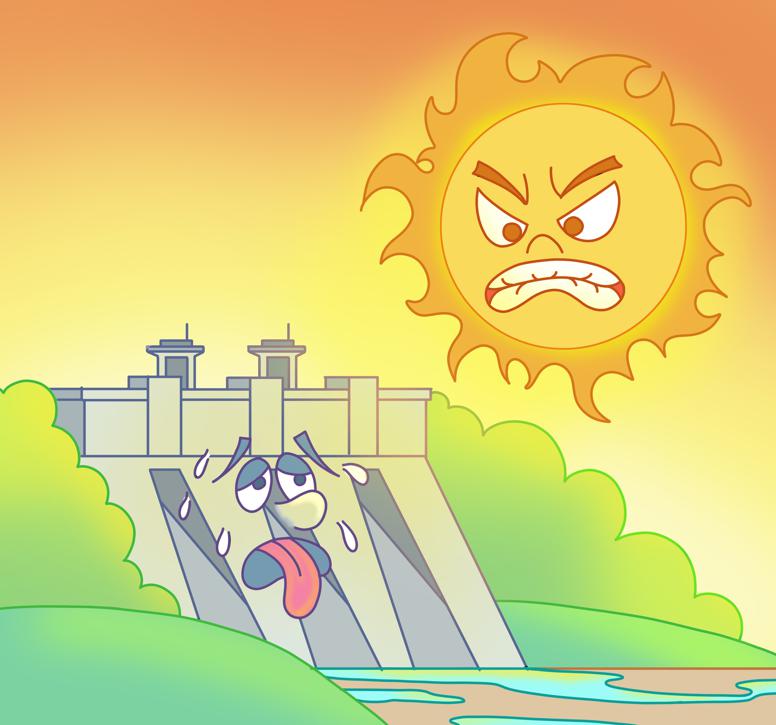Resilient water, power supply needed
By Han Wenke | China Daily | Updated: 2023-06-07 07:58

The impacts of climate change are becoming increasingly severe and widespread, with heat waves and droughts occurring more frequently. And many parts of China are also hit by the latest wave of heat this week.
Last summer, the Yangtze River region experienced the most severe drought and prolonged heat waves in more than 60 years, resulting in severe water shortage in the densely populated region and disruption in water and electricity supply.
Since the beginning of this summer, too, China and some neighboring countries and regions have been experiencing unusually high temperatures and localized droughts or drought-like conditions in some areas, raising fears of serious drought, and its impact on water supply and electricity generation.
Water scarcity caused by drought is basically a matter of water resources and water ecology. And addressing the water scarcity problem, like addressing water-related disasters and environmental issues, depends on the establishment of a systematically complete, safe, secure, efficient, eco-friendly, sustainable and well-regulated national water network.
China has made significant progress in this direction in recent years. Water supply security and the quality of river and lake ecosystems have greatly improved, with urban and rural water supply systems becoming more efficient and reliable. Yet given the increase in extreme weather events, it is necessary to further improve China's water supply infrastructure and make it more resilient to climate change.
Drought and extreme heat affect hydroelectric power generation. However, since the start of the 14th Five-Year Plan (2021-25) period, the storage capacity for energy has been continuously increasing, while the demand-side energy regulation has improved and the power system has become more resilient to extreme weather events.
Despite that, various measures need to be taken to ensure regular power supply or minimize power rationing when hydroelectric power generation is affected by extreme weather events or electricity demand increases drastically due to extreme heat or drought.
Also, production of renewable energy, mainly wind and solar power, is likely to increase at a faster pace this year and play a bigger role in meeting the energy demand when hydroelectricity generation is affected by extreme weather events. In 2022, China produced 1.35 trillion kilowatt-hours of hydropower and 1.19 trillion kilowatt-hours of wind and solar power, which shows solar and wind power generation is catching up with hydroelectricity production.
Besides, in the first quarter of this year, China increased the capacity of installed renewable energy, including hydropower, by 47.4 million kilowatts, up 86.5 percent year-on-year. Apart from 1.21 million kilowatts of hydroelectricity, the rest of the installed energy capacity comprised pumped storage, wind, solar and biomass power and other sources. While total renewable energy production increased by 11.4 percent year-on-year, wind and solar power production rose by 27.8 percent.
According to plans, increased wind and solar power generation will add 160 million kilowatts to the installed renewable energy capacity this year. Unless there is an exceptionally severe drought or extreme heat events, the reduction in hydropower generation due to drought and reduced water supply can be supplemented by renewable energy such as wind and solar power.
In addition, extreme heat often leads to higher demand for electricity, causing power supply shortages in certain regions. China is a large country with a massive economy, but it still faces the problem of inadequate and unbalanced regional development. As a result, some regions experience intermittent power cuts and disruptions in power supply due to reduced power production.
So apart from increasing the supply of clean power other than hydropower, it is also important to further adjust the power generation and supply system by, for instance, fully using demand-side resources such as adjustable loads including air conditioning loads, new energy storage capacity, distributed power sources and electric vehicles.
There is also a need to implement policies that support the use of these flexible resources to meet the power demand through methods such as load aggregators or virtual power plants. And these support policies should be extended to local power grids, incremental distribution networks and microgrids. It is also necessary to enhance the capability to meet any rise in power demand with significant differences in peak and off-peak electricity loads.
Moreover, such efforts should be combined with measures such as auxiliary service markets and electricity trading to share adjustable resources on a larger scale within the power grid.
The author is a senior counselor and researcher at the Institute of Energy Research, Academy of Macroeconomic Research.
The views don't necessarily reflect those of China Daily.
























